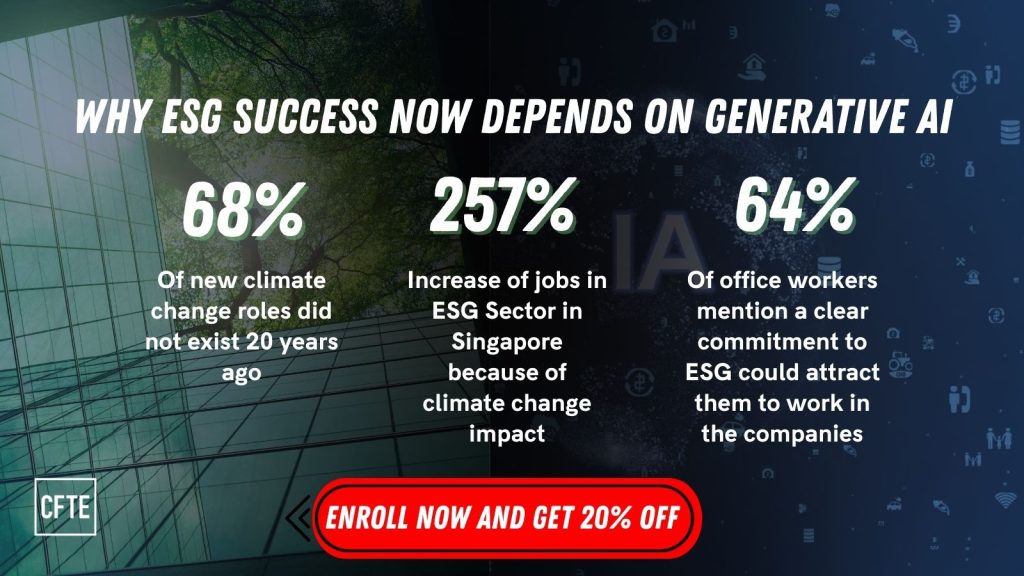
Why the ESG Leadership Gap Is Growing
Across global finance, the conversation on climate change has shifted dramatically. What was once framed as a “future challenge” is now discussed in urgent, quarterly board meetings. Regulators are implementing mandatory climate disclosures. Investors are asking tougher ESG questions. Customers want tangible proof of sustainable practices, not just glossy annual reports.
And yet, in this high-pressure environment, there’s a disconnect. Many senior leaders — even those deeply committed to ESG — do not have the tools or training to integrate Generative AI into their sustainability strategies.
The numbers speak for themselves:
- 43% of financial institutions are already using Generative AI in some business functions, but ESG applications remain rare (NVIDIA, 2024).
- Two-thirds of digital leaders believe GenAI will transform their industry, yet ESG teams are often left out of digital transformation roadmaps (McKinsey).
- According to the WEF, 32–39% of tasks in banking, insurance, and capital markets could be automated with GenAI, freeing up talent for more strategic sustainability work.
The gap isn’t about lack of will. It’s about lack of capability — and that’s exactly where upskilling becomes critical.
Three Reasons the Gap Persists
Technology Outpaces Training
AI innovation cycles are measured in months, while corporate training programmes are often updated annually. ESG leaders can’t afford to be a year behind.
Siloed Expertise
ESG specialists understand climate risks and sustainability frameworks, but may have little exposure to AI tools. Data scientists understand AI but may lack ESG context. These silos mean missed opportunities.
Complex Regulatory Environment
From the EU AI Act to TCFD climate disclosures, leaders are juggling multiple compliance demands — often without a unified strategy that merges AI and ESG requirements.
How Generative AI Closes the Gap
Generative AI has the potential to transform ESG strategy execution in ways that were previously impractical or impossible:
1. Automated ESG Data Processing
Large language models can process massive volumes of unstructured ESG data — from sustainability reports to climate risk studies — and extract actionable insights in seconds.
2. Climate Risk Modelling
Generative AI can simulate climate impact scenarios for investment portfolios, using data from multiple geospatial and economic sources. This enables better-informed decision-making in asset allocation and risk management.
3. ESG Reporting at Scale
Customised, jurisdiction-specific ESG reports can be generated quickly, ensuring compliance with global frameworks while tailoring messaging for stakeholders.
4. Stakeholder Engagement
AI can generate targeted sustainability communications for investors, regulators, and internal teams, ensuring clarity and alignment across all audiences.
Case Study: AI in Action for ESG
The Bank for International Settlements (BIS) used Generative AI to extract ESG-relevant data from 187 banks worldwide (Thomson Reuters).
This project demonstrated AI’s ability to standardise ESG metrics across diverse datasets — a task that previously required months of manual work.
The Skills Leaders Need Now
Bridging the ESG leadership gap isn’t just about knowing that AI exists — it’s about being able to direct AI strategy, understand its limitations, and ensure ethical deployment. That means leaders need:
- Foundational AI Literacy — How Generative AI works and where it fits in ESG.
- Hands-on Tool Experience — From ChatGPT for report generation to AI climate modelling platforms.
- Governance Knowledge — Navigating ethical considerations, bias risks, and compliance frameworks.
How This Course Helps You Close the Gap
The Generative AI for Climate Change in Financial Services course was built to address exactly this need. Over 6 weeks, with just 15 minutes a day, you will:
- Gain practical experience with AI tools for ESG applications.
- Learn from real-world case studies across banking, technology, and climate sectors.
- Understand global regulatory landscapes and ethical frameworks.
Instructors include Huy Nguyen Trieu (CFTE Co-Founder) and Amit Agrawal (Senior Climate Tech Advisor), combining deep expertise in finance, technology, and sustainability.
Why This Is the Moment to Act
The ESG leadership gap is not a static challenge — it’s widening. Financial institutions that fail to integrate AI into their ESG strategies risk losing competitive advantage, failing compliance checks, and eroding stakeholder trust.
On the flip side, leaders who act now will:
- Reduce operational inefficiencies in ESG reporting.
- Enhance strategic agility in climate risk management.
- Strengthen investor confidence through transparent, AI-enhanced data.
💡 Special Offer:
Until 21 August 2025 , save 20% on enrolment with code ClimateChangeLaunched2025.
Secure your place in the next cohort and be the leader your institution needs.
